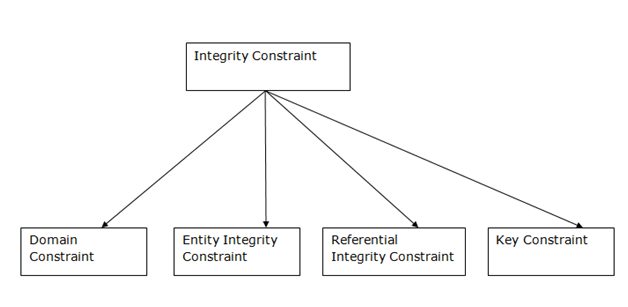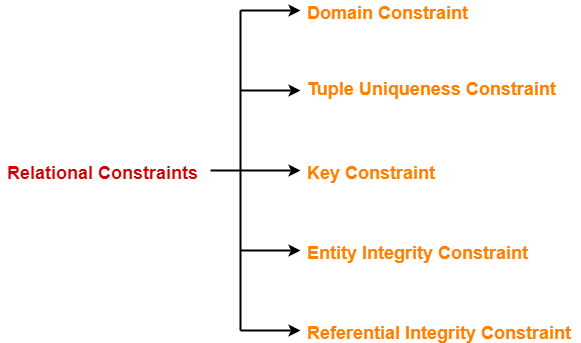Explain Different Types of Constraints in Dbms
High-cardinality refers to columns with values that are very uncommon or unique. A Network database management system is a system where the data elements maintain one to one relationship 1.

Dbms Integrity Constraints Javatpoint
Constraints in the databases can be categorized into 3 main categories.

. The UNIQUE and PRIMARY KEY constraints both provide a guarantee for uniqueness for a column or set of columns. High-cardinality column values are typically identification numbers email addresses or user names. Primary Key is a column or group of columns in a table that uniquely identify every row in that table.
High-cardinality normal-cardinality and low-cardinality. These are called as schema-based constraints or Explicit constraints. Super Key A super key is a group of single or multiple keys which identifies rows in a table.
UNIQUE Constraint enforces a column or set of columns to have unique values. This constraint specifies the number of instances of an entity that are participating in the relationship type. DBMS Database Big Data Analytics Constraints are used for modeling limitations on the relations between entities.
Constraints enable the RDBMS enforce the integrity of the database automatically without needing you to create triggers rule or defaults. How to find cardinality. It provides the conceptual tools for describing the design of a database at each level of data abstraction.
The DEFAULT constraint provides a. If a column has a unique. A primary key is a constraint in a table that uniquely identifies each row record in a database table by enabling one or more the columns in the table as the primary key.
There are several types of constraints available in DBMS and they are. There are primarily two types of integrity constraints that help us in ensuring the uniqueness of each row namely UNIQUE constraint and PRIMARY KEY constraint. This means that we cannot insert a Null value for that column while inserting a new row in the table.
It also has a hierarchical structure but the data is organized like a graph and it is allowed to have more than one parent for one child record. The unique key helps in uniquely identifying a record in the data table. The types of cardinality constraints are mentioned below.
There are two types of constraints on the Entity Relationship ER model Mapping cardinality or cardinality ratio. Domain constraints Entity Integrity constraints Referential Integrity constraints Key constraints In this article we will only discuss domain constraints. Data Model is the modeling of the data description data semantics and consistency constraints of the data.
Explain different types of constraints. Below given are different kinds. Unique keys are defined at table.
Specifying check constraints is done through a restricted form of a search condition. Lets look at each of the keys in DBMS with example. The UNIQUE constraint uniquely identifies each record in a database table.
Types of constraints NOT NULL. NOT NULL constraint makes sure that a column does not hold NULL value. It can be considered somewhat similar to the Primary key as both of them guarantee the uniqueness of a record.
Constraints on the Relational database management system is mostly divided into three main categories are. A PRIMARY KEY constraint automatically has a. 1 or many to many relationship N.
If we dont enter any value in a particular column it will store NULL if the default value has not been specified. It is also called the minimum cardinality constraint. NOT NULL Constraint This constraint is used when you do not want any value in that particular column to be a Null value.
When dealing with columnar value sets there are three types of cardinality. When we dont provide value for a. These Relational constraints in DBMS are derived from the rules in the mini-world that the database represents.
NOT NULL - Ensures that a column cannot have a NULL value UNIQUE - Ensures that all values in a column are different. In a Relationship Participation constraint specifies the presence of an entity when it is related to another entity in a relationship type. NOT NULL UNIQUE PRIMARY KEY FOREIGN KEY CHECK DEFAULT NOT NULL Constraint By default a column can hold NULL values.
There are two types of Participation. Constraints that are directly applied in the schemas of the data model by specifying them in the DDL Data Definition Language. There are many types of Integrity Constraints in DBMS.
Table Check constraints A check constraint also referred to as a table check constraint is a database rule that specifies the values allowed in one or more columns of every row of a table. The NULL value is omitted in various operations in a database. The following constraints are commonly used in SQL.
Foreign key referential constraints. Constraint Types DEFAULT. Creating a primary key A particular column is made as a primary key column by using the primary key keyword followed with the column name.
Constraints can be column level or table level. Types of SQL Constraints. This type of constraint allows us to define a value to be used for a given column when no data is provided at.
Domain Constraints Key Constraints Referential Integrity Constraints. Therefore every field in this column always has a non-Null value. Column level constraints apply to a column and table level constraints apply to the whole table.
Constraints that are applied in the data model is called Implicit constraints. Therefore there are following four data models used for understanding the structure of the database. CHECK constraints allow us to define a logical condition that will generate an error if it returns FALSE.
These constraints specify the number of entity instances which associates with instances of another entity.

Constraints In Dbms Types Of Constraints In Dbms Gate Vidyalay

Integrity Constraints In Dbms Types Of Integrity Constraints In Dbms
Comments
Post a Comment